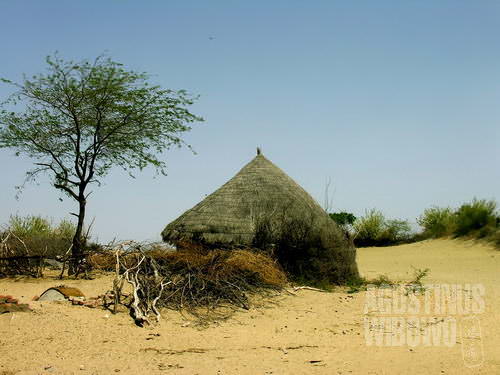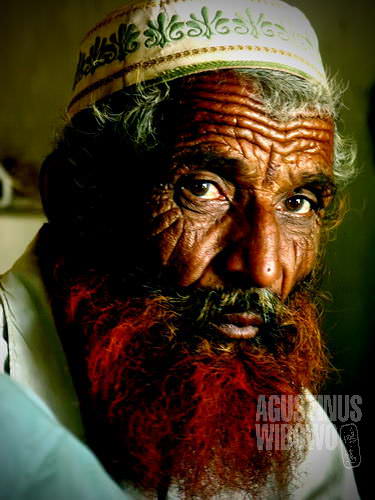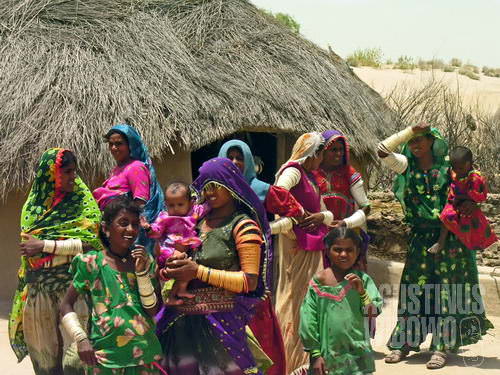Umerkot – A Day in Tharpakar
May 17, 2006

Hut in the middle of desert
Today is another ‘field’ day for the social workers in Sami Samaj Sujag Sangat NGO in the desert area near the Indian Border, South Pakistan. Today, as the activities of previous weeks, the workers visited the villages (what they called as ‘fields’) in the deep desert of Tharpakar to introduce the new machine-readable ID card (computer sekhnati card) to the people deep in the desert. The people lived so much scattered in the dry desert of Tharpakar, isolated from outside world, uneducated, and unregistered. The NGOs were working hard to make data of how many people to be distributed ID Cards, but it was not an easy work considering the area and the fact that most of these desert people are still nomadic.
Today we visited six villages; one village among them was half deserted already, left by the inhabitants to somewhere else greener. The desert was very dry, after years of drought, despite the fact that now was monsoon season, and people kept traveling to find greener and wetter area for their life and their cattle. It was noticeable, that all animals in this yellow dry desert: camels, cows, donkeys, sheep had skinnier appearance than their counterparts in the town area. A row of died sheep marked the entrance to a village that we visited today, clearly died of hunger. The village women also had to walk some kilometers away under the fierce sun heat to collect water from the nearest water well, dig by some charity organizations. They didn’t do it in early morning when the sun was calmer. They might walk kilometers by kilometers on the burning sand dunes, barefooted.

Muslim old man with colored beard
Villagers in a village generally had blood relation each other, thus, each village was of the same religion. There were Muslim villages, and also Hindu villages. They were different each other from the way of speaking, some dress codes, and some dialects they used. The village women, no matter Muslims or Hindu, still wore the traditional bangles of various sizes making long row covering their arms. Most of the Hindu women(and some Muslim women also) had distinctive of choli (shirt) and polka (long skirt), while the Muslims still sticked on shalwar kameez. The males were wearing shalwar khameez, the Muslims had their caps on. But Prakash, a Hindu social worker from the NGO told me, it was the dialect they speak the main tool to determine whether they were Hindus or Muslims. Many Hindu people here were from Sudra caste, the lowest in their religion, but they maintain to speak the Mawari dialect, a reputable dialect of the Rajputs in Rajasthan. No matter of which religions, most villagers in the desert don’t speak Urdu, the national language of Pakistan, and had very limited mastering of Sindh, the local language of the province. Almost all of them were illiterate, but at least there should be one young man from the village who got educated in the nearby town. The children were playing around the whole day under the fierce sun, without worrying about algebra homework or science teachers. In fact most of them had never seen teachers in their life. In some villages near to the town the government had built schools, but for the villages in the heart of desert, education and health service are luxury. There was almost no way for them to even reach Umerkot, except if they could afford the costly public transport from the main road after struggling walking on the hot soft sands.

Wasayo Bheel
The Hindu women in the village of Soomon Bheel, some 20 kms away from Umerkot, were happy to see Mumtaz, a woman social worker from the NGO. Mumtaz did most of the field work of the NGO. She was Muslim, and was raised in deep desert, that the harsh environment didn’t worry her too much. She didn’t speak much Urdu, but had a very good command in the local languages, so that she could give briefing and sessions to the villagers in their own tongue. The women of Dheel were wearing colorful sarees, with the arm bangles and face piercing. There were no men visible in the village. It seemed that all men were going somewhere to work and the women, dozens of them in this village, kept the little babies. The women were happy with photography. They were posing in front of the little hut, the community hall or chowra, and were very patient to make beautiful poses under the hot sun. Mumtaz explained about the ID card program. The innocent old ladies asked her, whether the photographer (me) was only playing with them, because I clicked the camera for many times but not even single flash coming out. They thought that I was just merely playing with them. “Why no chulka, chulka (flash), only prek prek prek (the sound of clicking camera)?”

Four years no rain
The NGO usually used the cheap Yashica camera when taking pictures of their project with the villagers, and the people were very happy with the flash coming out from the camera. The fact that I didn’t use flash (under the overexposing sunlight) did really disappoint the ladies.
As innocent as ladies in Dheel, the ladies in Wasayo Bheel village were screaming when I took pictures of them. Actually I didn’t their language, but some words resembled Urdu words, and I just left them away and took pictures of their children instead. Mumtaz was involved with discussion with the women, I just heard some words like “hotel”, “restaurant”, “foto foto”, but didn’t find the correlation.
Later on Mumtaz explained to me, that the ladies were worrying about taken pictures by foreigners.
“Are our photos going to be sent to foreigners, for modeling, to be put as posters in hotels and restaurants?” said a lady innocently. While saying about ‘modeling’ she made a pose by putting a hand on her head and the other hand on her waist, a supermodel pose.
“No. You are not that beautiful to be on posters in hotels and restaurants,” said Mumtaz, “we just took your photos to be put in our office.”

On action in front of camera
Later on that day, I saw the pictures of the same innocent look ladies from the desert. This time was on Dawn Newspaper, under an article that minorities were demonstrating supporting Muslim charities. The news said that Hindu and Christian minorities were having demonstration in Karachi against the US declaration that Jamaat-ul-Dawa as terrorism organization. The desert ladies with the colorful dress and bangles along the arm plus facial piercing, with very innocent face not showing anger nor understanding about what they were protesting about, held a banner, “Jamaa Dawa Our Savor”.
The organization they were supporting about was signalized as the re-incarnation of Lashkar, a Muslim militant group that encouraged jihad to the religious youngsters. But the new institution camouflaged as a social organization, building wells in the deep desert, building educational institutions in the backward area, suspected to have a hidden agenda. The poor Hindu and Christian minorities also enjoyed some of their works.
It’s still long way to go for these women from the deep desert of Tharparkar to really understand their politic ideas and what they were struggling about. Even the alphabets had not reached them yet.



Liputan bagus! This is one of your best, I like this short but detail description. You are getting better each day, both your photos (of course) and writing. Keep going !
Gua suka liputan yg ini Gus, ngga tau kenapa. Foto anak kecil itu juga top banget deh. Kayak liat fotonya Steve McCurry aja hehehe.
Maybe you should include a map yah. Rasanya kalo gua ngag tau tempat yg elo ceritain itu gua jadi agak males bacanya. Kalo elo cerita tentang Tibet or China gitu gua masih tau elo ngomongin apa. Tapi ini elo udah masuk Pakistan and talking about some cities called bla bla bla … hell I dont even know where it is.
And mungkin buat some people kadang bisa males soalnya ngga gitu demen ama culture-nya. Like me, if you’re talking about Chinese history, Chinese culture as well as Greek’s culture/history, Egypt culture/history, France culture/history, I would be glad to read it several times. But when you’re talking something like American culture/history, Singapore culture/history, I would be bored to death.
And for your particular journal like this Pakistan, even though I don’t dislike it, I still don’t love it. Do you get what I mean ?
Syabas…
i love reading your articles, well written and i can imagine myself there watching the people and trying to envision the area/buildings.
Excellent job.. keep writing. Can’t wait for your next article. More pictures please .. thank you